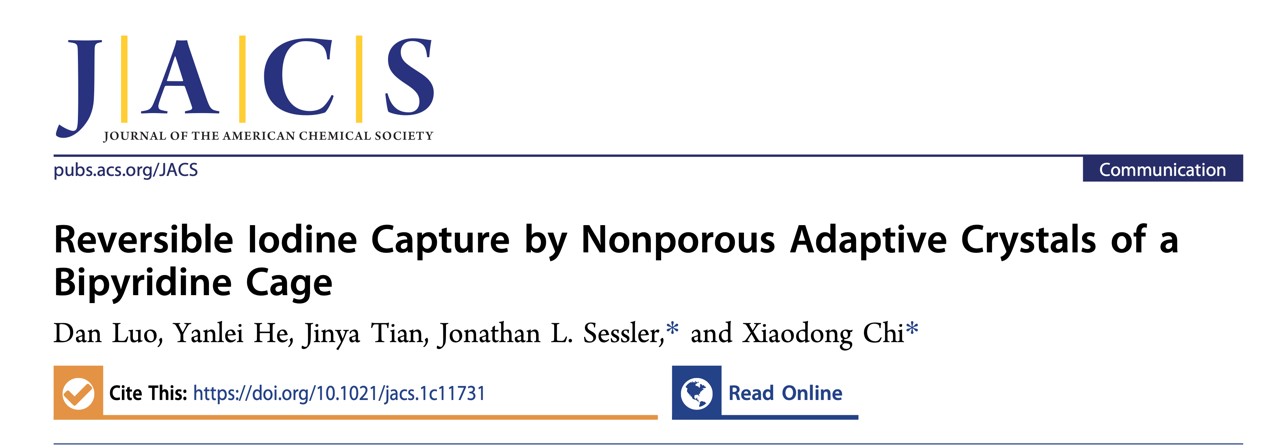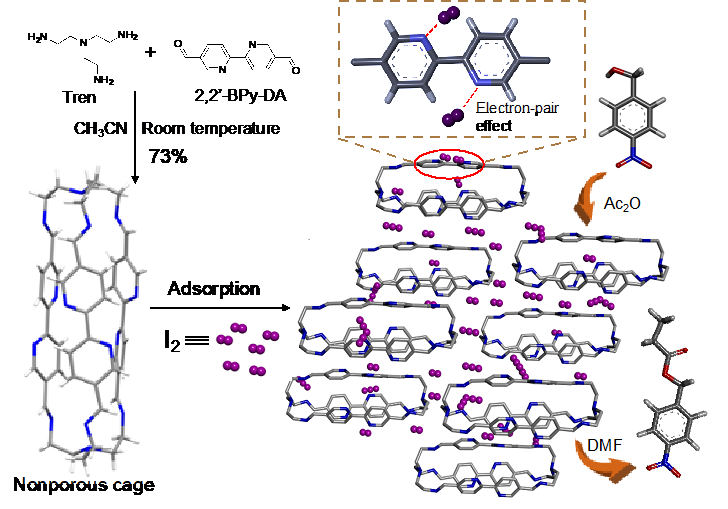On December 28th, a research paper titled “Reversible Iodine Capture by Nonporous Adaptive Crystals of a Bipyridine Cage” was published online in the Journal of the American Chemical Society. The paper was jointly conducted by Prof. Chi Xiaodong of the School of Materials Science and Engineering and Prof. Jonathan Sessler from the University of Texas at Austin. This paper reported a new readily obtainable nitrogen-rich nonporous cage (BPy-Cage) based on bipyridine building blocks that has shown excellent iodine capture properties. The iodine within the cage (I2@BPy-Cage) can be released quickly upon immersing the bound solid form in DMF, allowing for control over acylation reactions.

With the rapid growth in energy demand, nuclear energy, a non-greenhouse energy source, has attracted increasing attention in a number of countries.1 However, the radioactive iodine present in nuclear waste poses a special management challenge due to its negative impact on the environment and living organisms. Among the iodine radioisotopes, 129I is of particular concern because of its long half-life (∼1.6 × 107 years), toxicity, and high mobility in most geological environments. It thus needs to be captured effectively and stored reliably. 131I is also problematic since it may be released into the environment under conditions of a nuclear power plant failure. This short-lived isotope (half-life: 8.02 days) is noteworthy for its intense radiation and the direct negative effect it can have on human metabolic processes. Therefore, the search for suitable adsorbents to capture iodine with long-term storage has become an urgent problem to be solved.

Organic cage-based nonporous adaptive crystals (NACs), have emerged as a new class of synthetic materials with promising adsorption properties due to their accessible windows, easy preparation and scalability. In comparison with traditional porous materials, like MOFs and COFs, which are typically characterized by large surface areas, NACs are relatively nonporous with excellent thermal stability. On the other hand, they are formally adaptive in that capture of appropriately chosen guests that lead structural changes in the crystalline state; this makes them attractive candidates for iodine capture. Recently, Prof. Chi Xiaodong of the School of Materials Science and Engineering and Prof. Jonathan Sessler from the University of Texas at Austin reported a new nitrogen-rich bipyridine-based nonporous adaptive cage (BPy-Cage) that is effective for the capture of iodine, both from vapor and from organic and aqueous media. This capture has an iodine uptake capacity of up to 3.23 g g-1, which is 5-fold higher than that of the CC3 porous organic cage molecule, 20-fold higher than that of the nonporous ethyl pillar[6]arene-based molecular crystals and is similar to various porous organic crystal materials, such as COFs and MOFs. In addition, iodine could release spontaneously and quickly from I2@BPy-Cage solids when they are immersed in DMF solution, a finding that was exploited to modulate both the kinetics and extent of conversion of a representative acylation reaction. The present study thus underscores the utility of nonporous organic cages that target specific deleterious substrates, such as iodine in the present instance, not only in terms of their capture and release, but also control over their inherent reactivity.
The work was supported by the National Natural Science Foundation of China, and the Fundamental Research Funds for the Central University. Professor Chi Xiaodong of HUST and Professor Jonathan Sessler from UT Austin were co-corresponding authors. Doctoral student Luo Dan from HUST was the first author.
Paper link: https://pubs.acs.org/doi/10.1021/jacs.1c11731
Source: School of Materials Science and Engineering
Written by: Chi Xiaodong
Edited by: Scott, Jiang Jing
